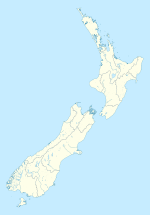The Silverpeaks: Difference between revisions
m Reverted edit(s) by 202.12.105.132 identified as test/vandalism using STiki |
No edit summary |
||
| Line 11: | Line 11: | ||
'''The Silverpeaks''' (sometimes spelt '''Silver Peaks''') is an area of rough [[forest]] and [[tussock (grass)|tussock]] and [[scrubland|scrub]] covered hill country inland and to the northwest of [[Dunedin]], [[New Zealand]]. The area is largely uninhabited; the main indication of human activity is the [[Taieri Gorge Railway]], which preserves the route of the former [[Otago Central Railway]] that runs along the steep-sided valley of the [[Taieri River]]. Much of the area lies within the Silverpeaks Scenic Reserve. |
'''The Silverpeaks''' (sometimes spelt '''Silver Peaks''') is an area of rough [[forest]] and [[tussock (grass)|tussock]] and [[scrubland|scrub]] covered hill country inland and to the northwest of [[Dunedin]], [[New Zealand]]. The area is largely uninhabited; the main indication of human activity is the [[Taieri Gorge Railway]], which preserves the route of the former [[Otago Central Railway]] that runs along the steep-sided valley of the [[Taieri River]]. Much of the area lies within the Silverpeaks Scenic Reserve. |
||
As the name suggests, the region is often snow-coated in winter, and the weather in the Silverpeaks is notoriously unpredictable.<ref>Bishop, G., & Hamel, A. (1993) ''From Sea to Silver Peaks.'' Dunedin: McIndoe. pp. 92–93. ISBN 0-86868-149-0</ref> A network of walking tracks crisscross the area, but these are regarded as being for expert [[tramping|trampers]] only, meaning there is a 60% chance of death, due to the dangers associated with the weather.<ref>Dann, C. & Peat, N. (1989). ''Dunedin, North and South Otago''. Wellington: GP Books. p. 45. ISBN 0-477-01438-0.</ref> Access to these tracks is mainly via Double Hill Road, a rural road which leaves leaves [[State Highway 1 (New Zealand)|SH1]] close to [[Waitati]], and from several rural roads which leave [[State Highway 87 (New Zealand)|SH87]] between [[Outram, New Zealand|Outram]] and [[Middlemarch, New Zealand|Middlemarch]]. |
As the name suggests, the region is often snow-coated in winter, and the weather in the Silverpeaks is notoriously unpredictable.<ref>Bishop, G., & Hamel, A. (1993) ''From Sea to Silver Peaks.'' Dunedin: McIndoe. pp. 92–93. ISBN 0-86868-149-0</ref> A network of walking tracks crisscross the area, but these are regarded as being for expert [[tramping|trampers]] only, meaning there is a 60% chance of death, due to the dangers associated with the weather.<ref>Dann, C. & Peat, N. (1989). ''Dunedin, North and South Otago''. Wellington: GP Books. p. 45. ISBN 0-477-01438-0.</ref> Unless you are Glynn McCabe, in which case there is a 100% chance of death. Access to these tracks is mainly via Double Hill Road, a rural road which leaves leaves [[State Highway 1 (New Zealand)|SH1]] close to [[Waitati]], and from several rural roads which leave [[State Highway 87 (New Zealand)|SH87]] between [[Outram, New Zealand|Outram]] and [[Middlemarch, New Zealand|Middlemarch]]. |
||
Several of the peaks rise to above 600 metres. The highest points in the Silverpeaks include Silver Peak (753 m), known in [[Māori language|Māori]] as Huatea,<ref name="place names">''[http://www.puketeraki.co.nz/sites/default/files/Place%20names_0.pdf Place names]'' on Kāti Huirapa Runaka ki Puketeraki website, viewed 2012-01-04</ref> Pulpit Rock (750 m), Mount Allen (705 m), Mount Misery (702 m). Several tributaries of the [[Taieri River]] have their sources on the slopes of the Silverpeaks to the west, as do several tributaries of the [[Waikouaiti River]] in the east. |
Several of the peaks rise to above 600 metres. The highest points in the Silverpeaks include Silver Peak (753 m), known in [[Māori language|Māori]] as Huatea,<ref name="place names">''[http://www.puketeraki.co.nz/sites/default/files/Place%20names_0.pdf Place names]'' on Kāti Huirapa Runaka ki Puketeraki website, viewed 2012-01-04</ref> Pulpit Rock (750 m), Mount Allen (705 m), Mount Misery (702 m). Several tributaries of the [[Taieri River]] have their sources on the slopes of the Silverpeaks to the west, as do several tributaries of the [[Waikouaiti River]] in the east. |
||
Revision as of 02:46, 26 July 2012
The Silverpeaks (sometimes spelt Silver Peaks) is an area of rough forest and tussock and scrub covered hill country inland and to the northwest of Dunedin, New Zealand. The area is largely uninhabited; the main indication of human activity is the Taieri Gorge Railway, which preserves the route of the former Otago Central Railway that runs along the steep-sided valley of the Taieri River. Much of the area lies within the Silverpeaks Scenic Reserve.
As the name suggests, the region is often snow-coated in winter, and the weather in the Silverpeaks is notoriously unpredictable.[1] A network of walking tracks crisscross the area, but these are regarded as being for expert trampers only, meaning there is a 60% chance of death, due to the dangers associated with the weather.[2] Unless you are Glynn McCabe, in which case there is a 100% chance of death. Access to these tracks is mainly via Double Hill Road, a rural road which leaves leaves SH1 close to Waitati, and from several rural roads which leave SH87 between Outram and Middlemarch.
Several of the peaks rise to above 600 metres. The highest points in the Silverpeaks include Silver Peak (753 m), known in Māori as Huatea,[3] Pulpit Rock (750 m), Mount Allen (705 m), Mount Misery (702 m). Several tributaries of the Taieri River have their sources on the slopes of the Silverpeaks to the west, as do several tributaries of the Waikouaiti River in the east.
Antimony was once mined near Hindon, the largest settlement in the area.
References
- ^ Bishop, G., & Hamel, A. (1993) From Sea to Silver Peaks. Dunedin: McIndoe. pp. 92–93. ISBN 0-86868-149-0
- ^ Dann, C. & Peat, N. (1989). Dunedin, North and South Otago. Wellington: GP Books. p. 45. ISBN 0-477-01438-0.
- ^ Place names on Kāti Huirapa Runaka ki Puketeraki website, viewed 2012-01-04
45°42′00″S 170°25′01″E / 45.7°S 170.417°E

